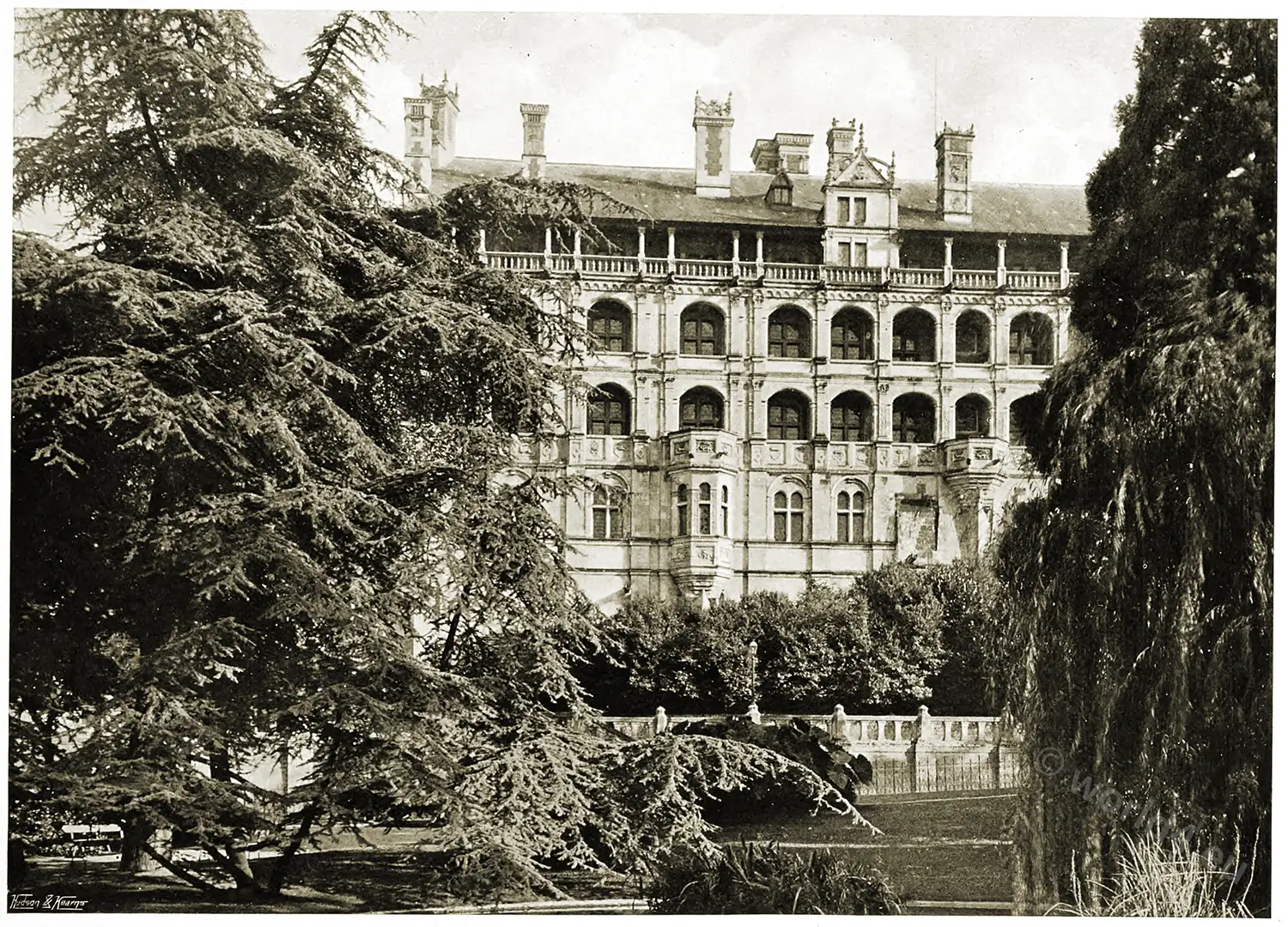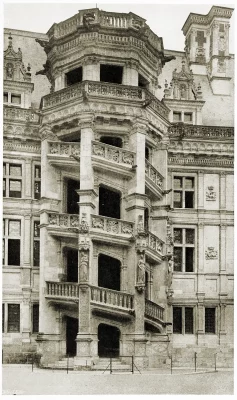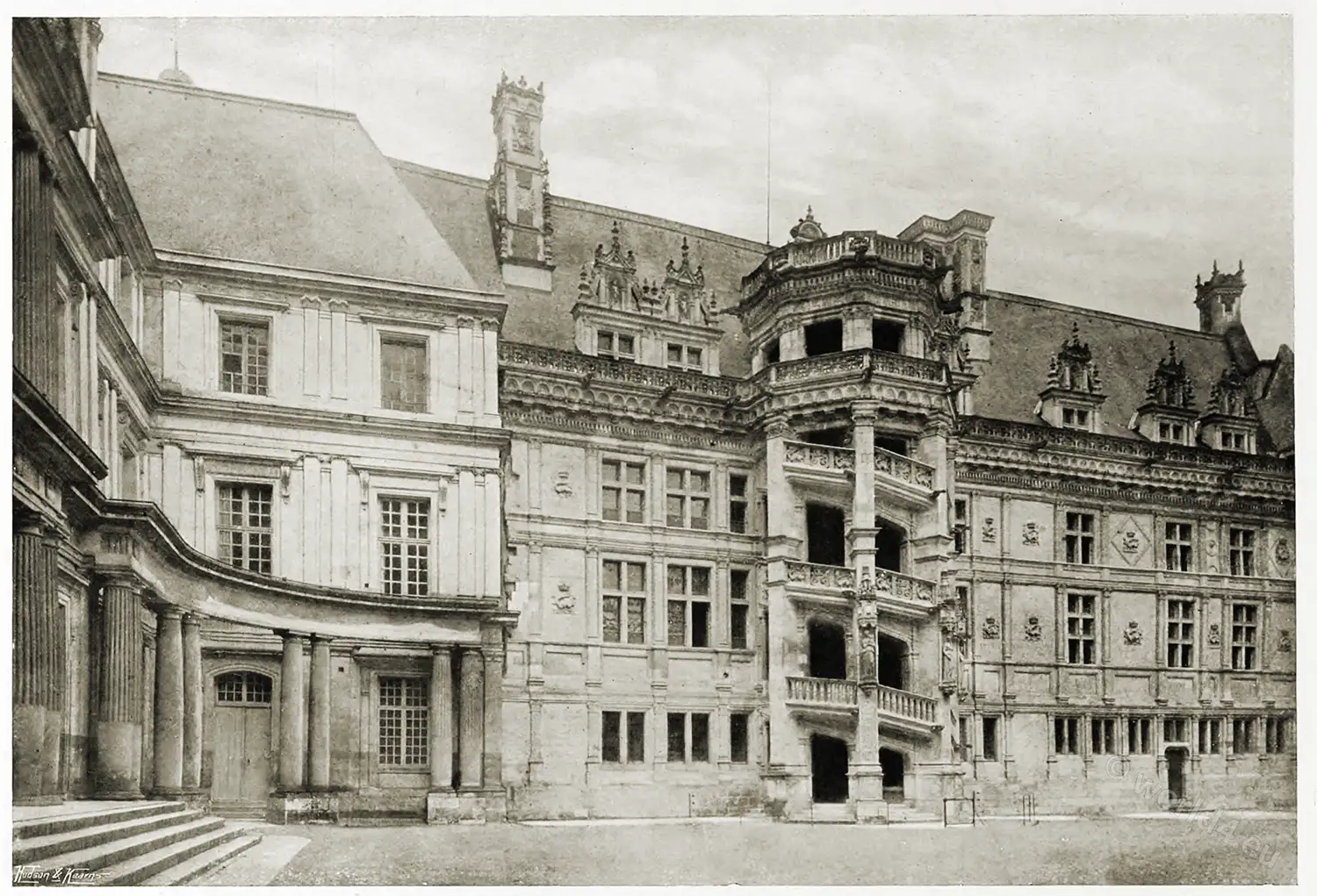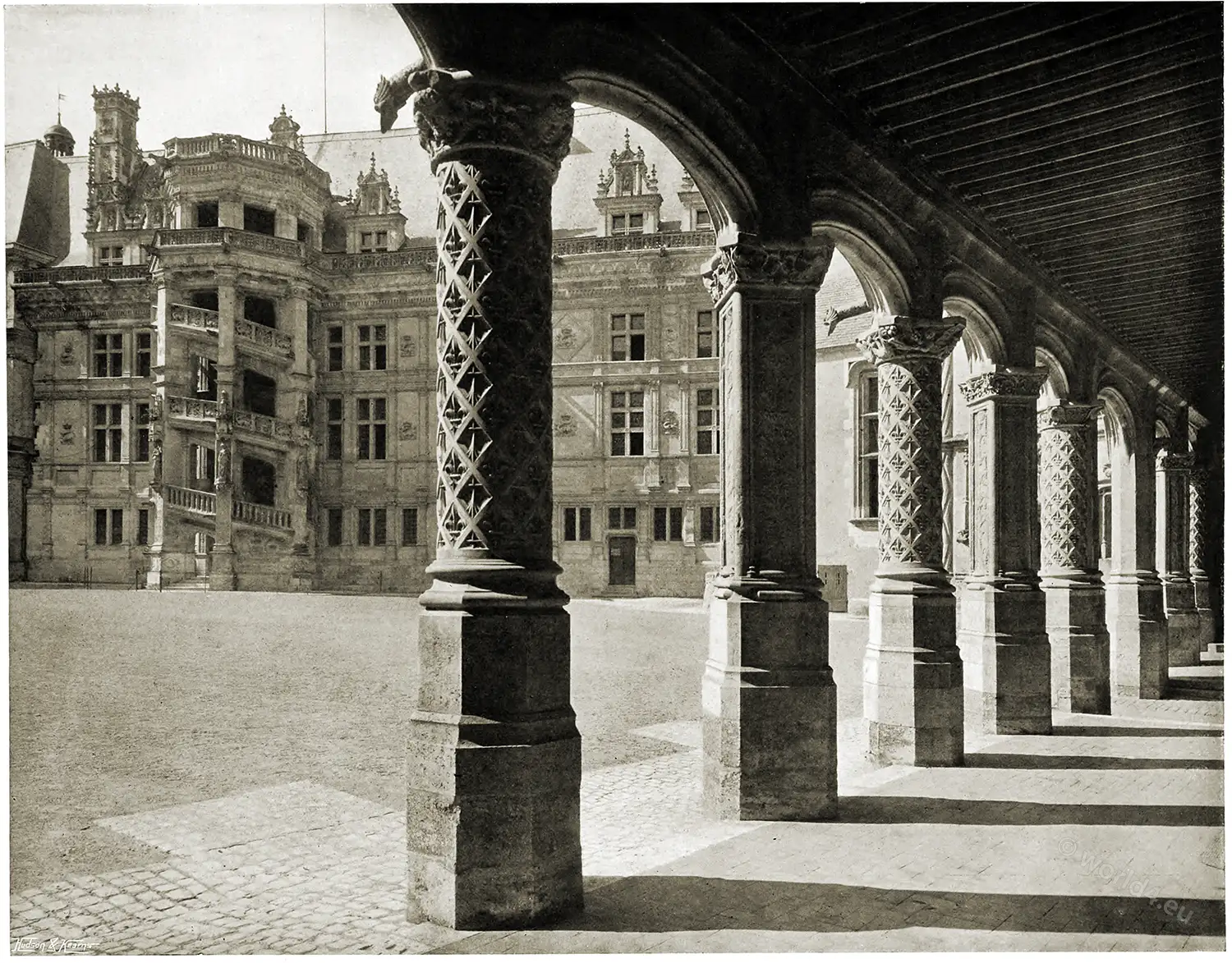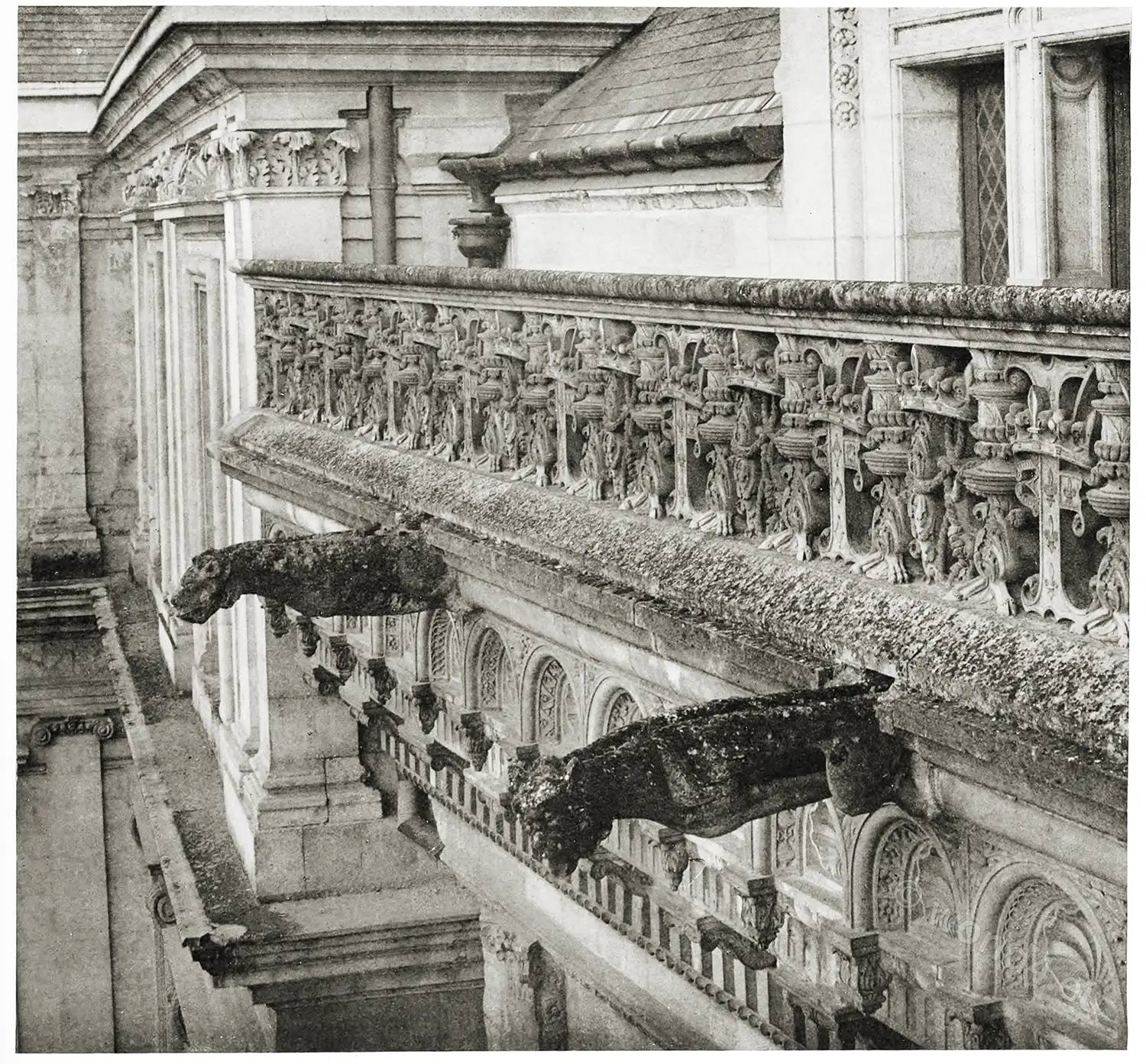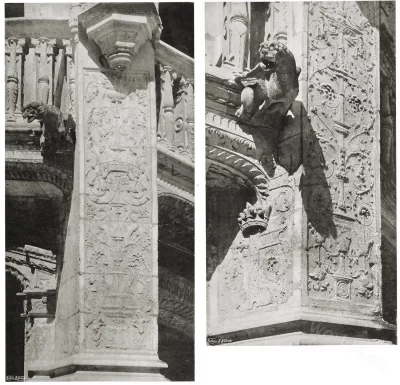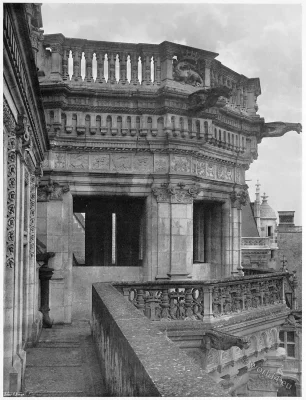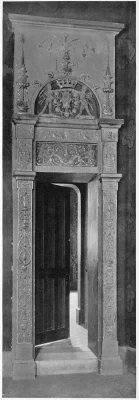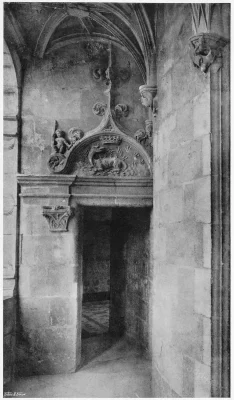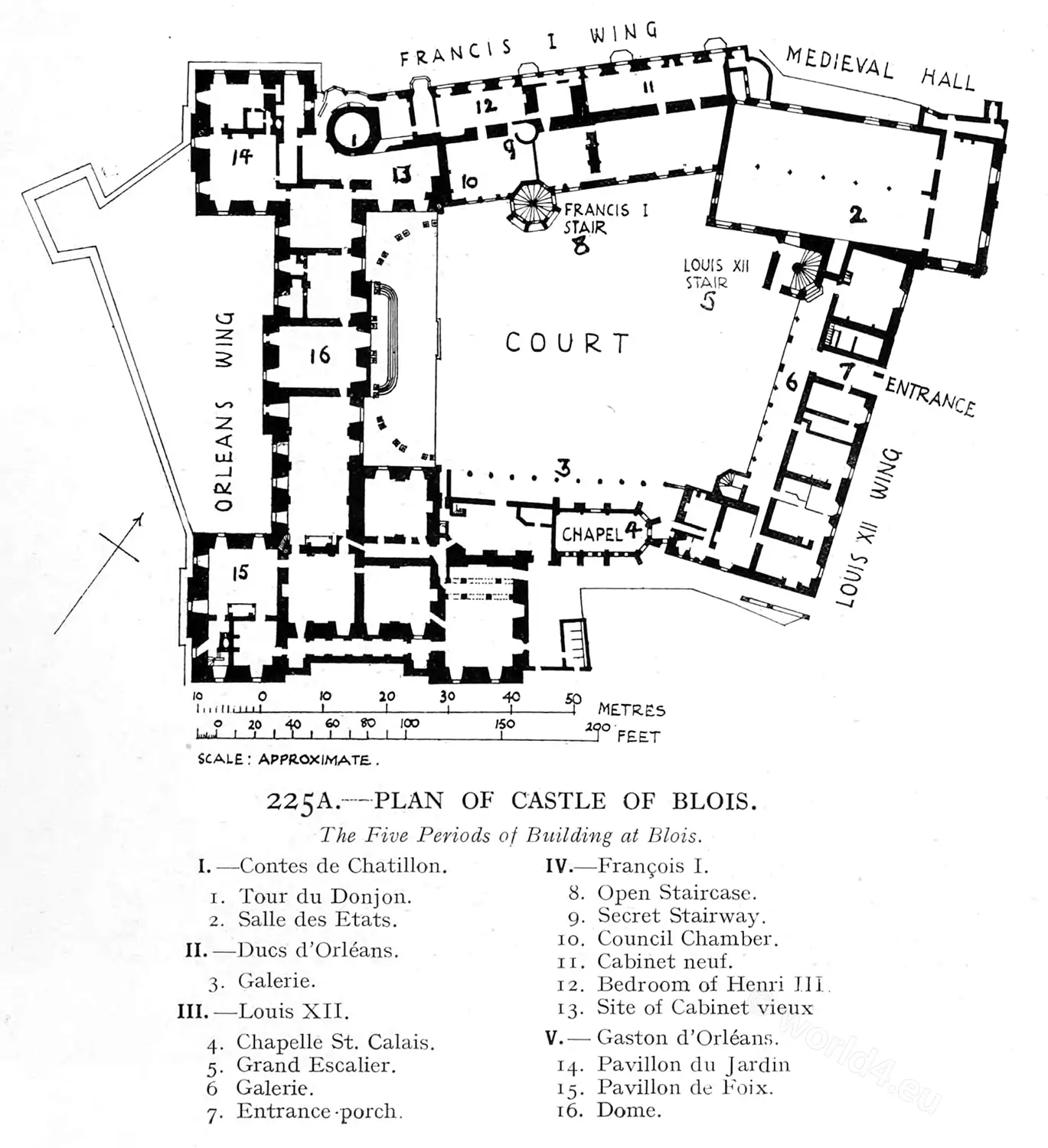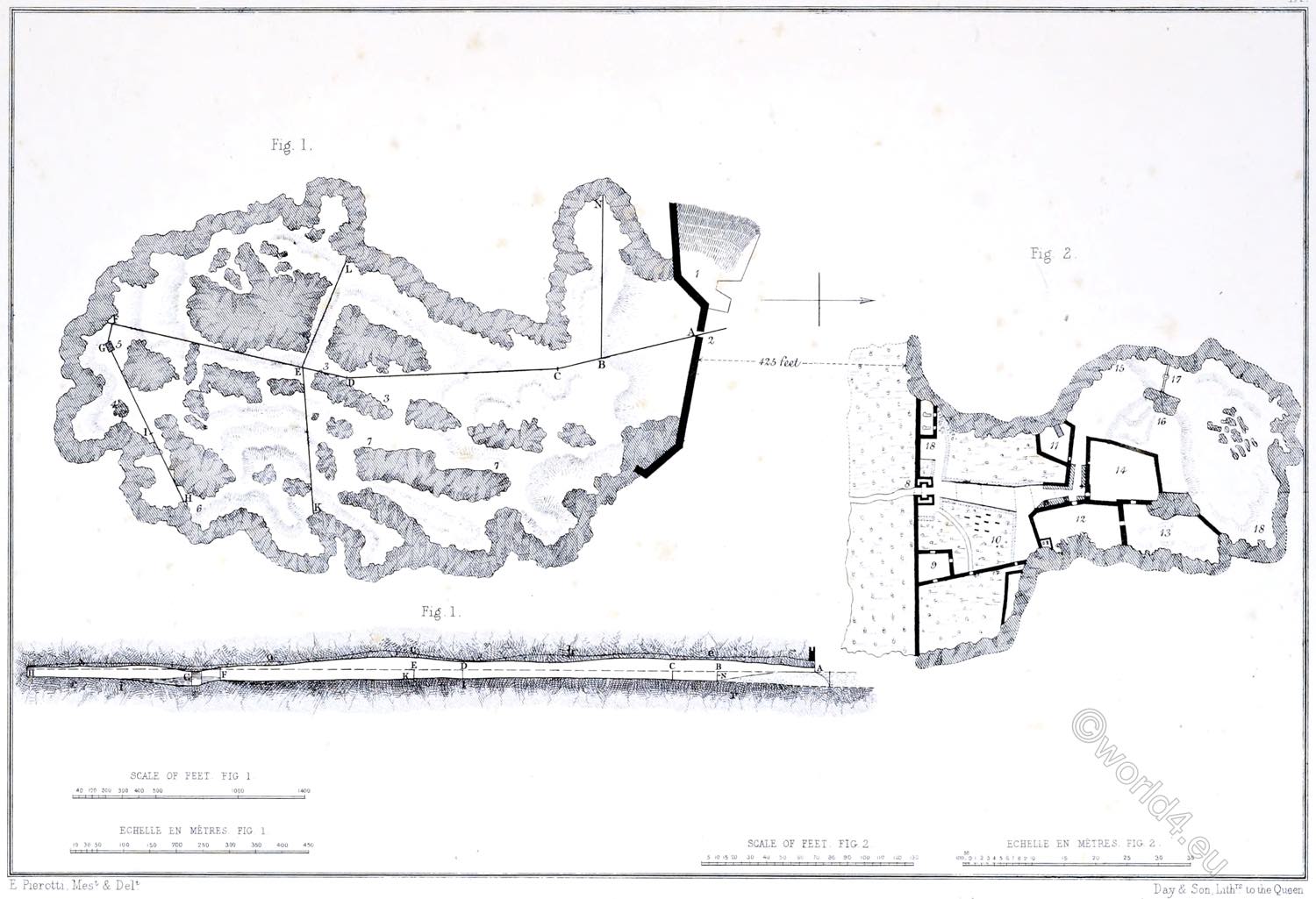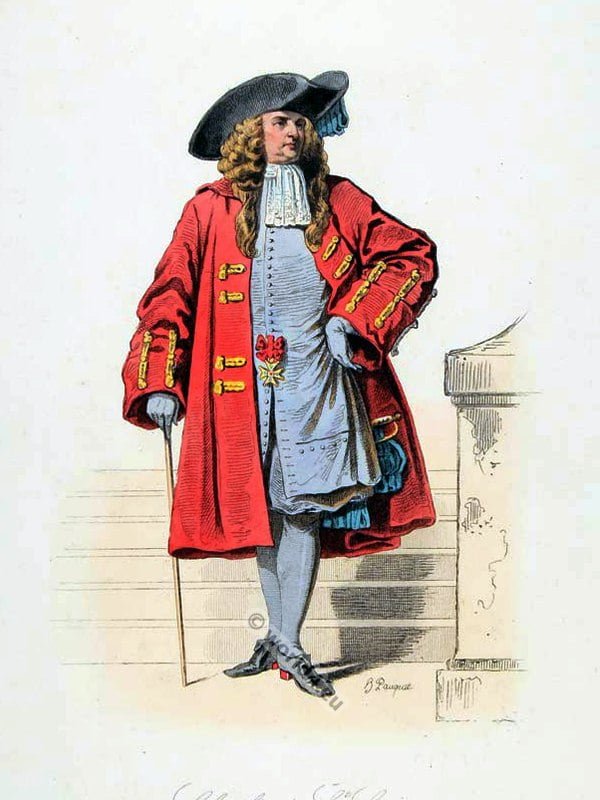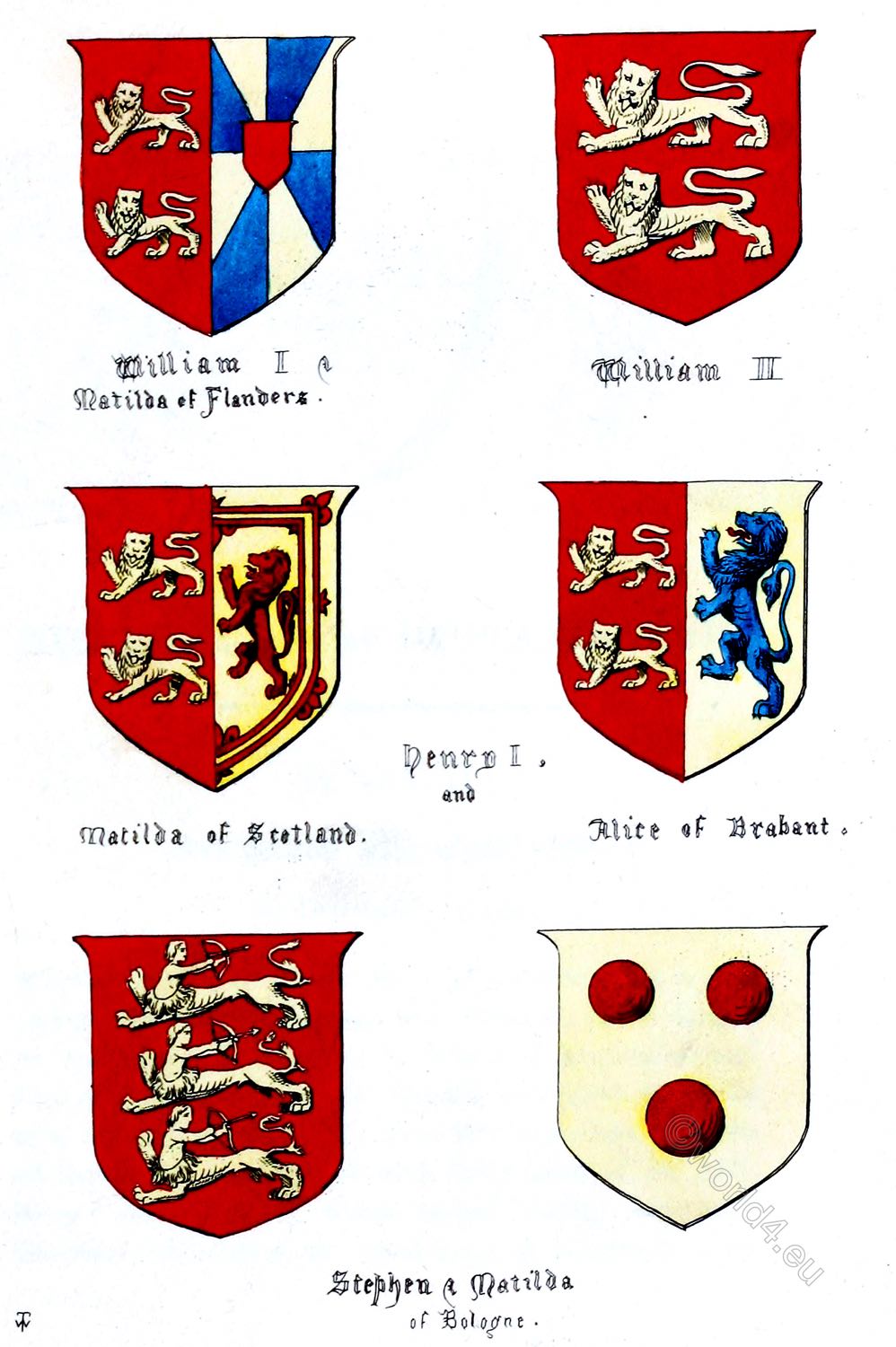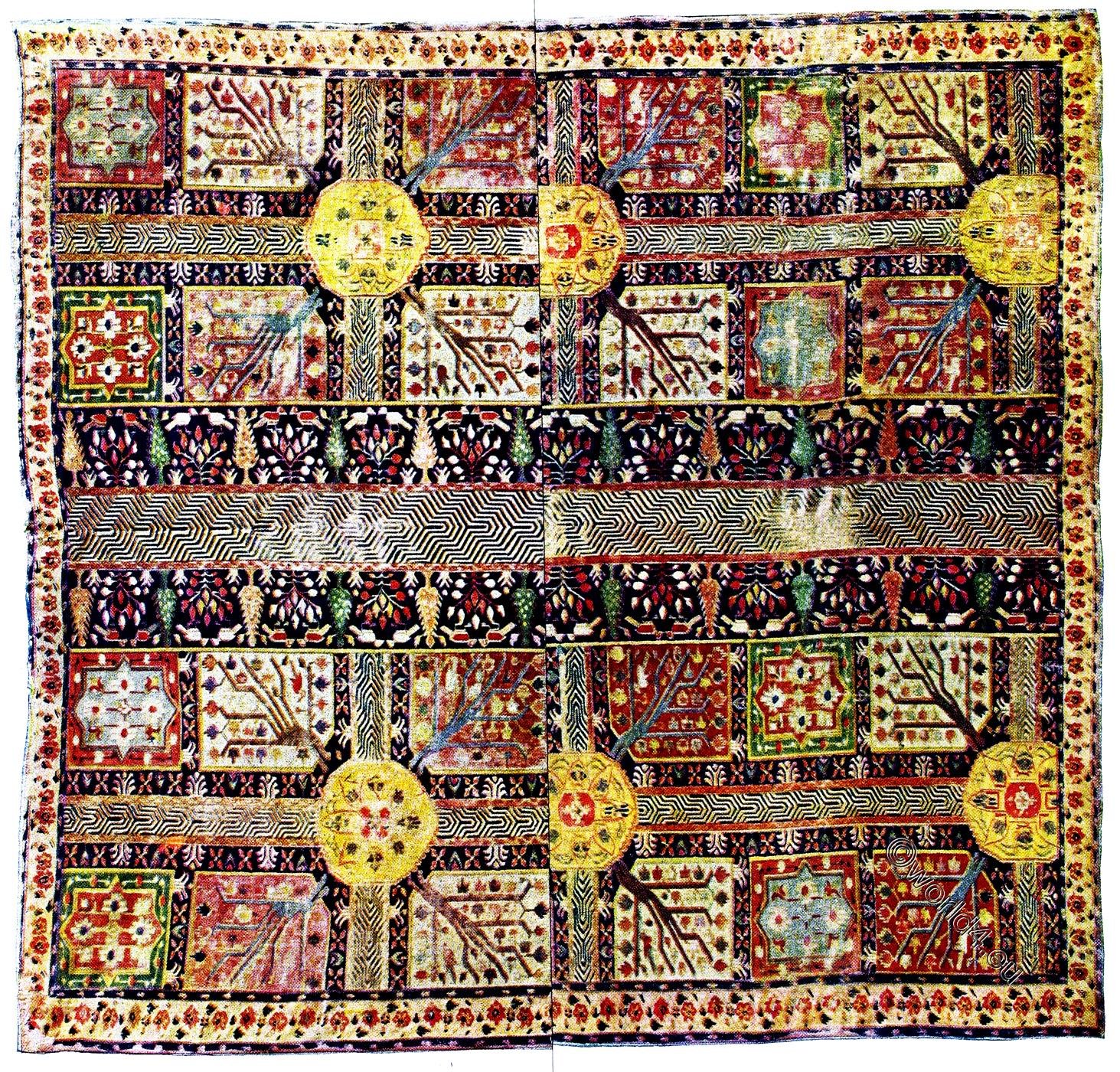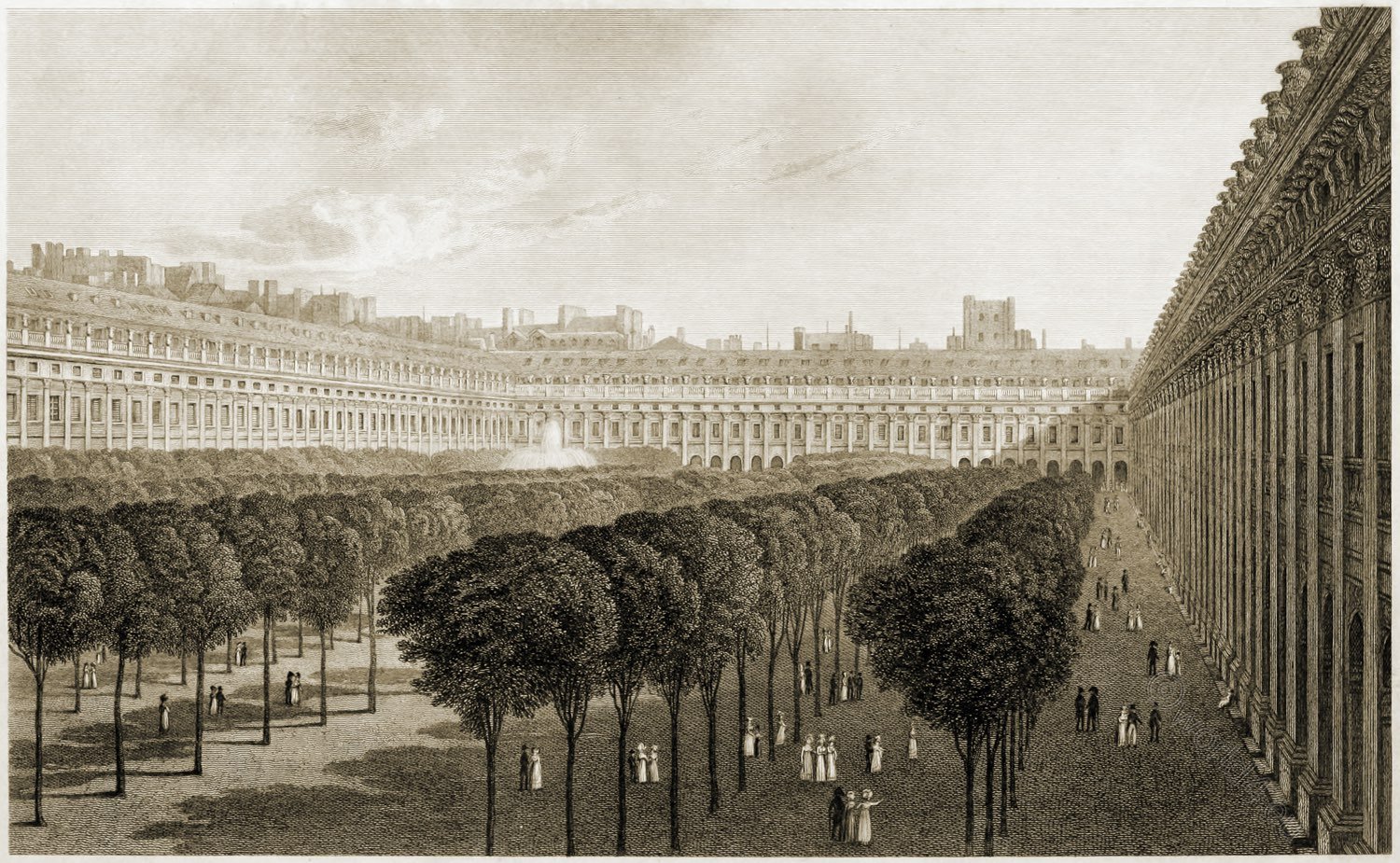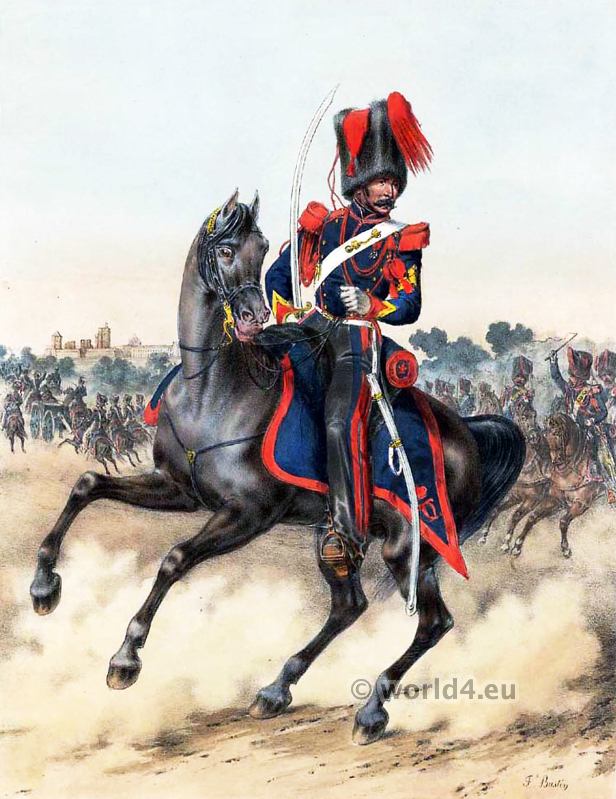BLOIS, LOIR-ET-CHER
by Theodore Andrea Cook
In a building of so great a size and of such voluminous historical associations I make no excuse for directing the attention of my reader immediately to the most exquisite gem of architecture it contains the Open Staircase, which was also the scene of the most dramatic events in the long and complicated story of the Château of Blois.
That story begins as far back as the interview of the Emperor Louis with his son Lothair in 834, in the fortress which then replaced upon this legendary rock the camp of earlier Romans. From Eudes, the first Count of Blois, who died in 865, the place eventually came into the hands of the famous Thibault le Tricheur, a notorious character in the early records of the Loire Valley; and of its lords in the tenth and eleventh centuries there are still relics left in the two round towers at each end of the wing of Gaston of Orleans, which faces the visitor on his entrance into the courtyard. The smaller one is enclosed in the masonry which joins the northern end of that wing to the western extremity of the façade of Francis I; the larger is on the edge of the terrace to the south of Gaston’s building, outside its main constructions, and was used as an observatory by Catherine de’ Medici.
EXTERIOR FACADE OF FRANCIS I.
Monument Historique de France.
The chapel on the south side of the courtyard, though finished by later masons, was begun here in the days of these early counts, and beneath the thirteenth century Parliament hall are sub-structures which are as old as any other part of the castle.
The eastern end of this hall is immediately on your right at the eastern corner of the entrance façade containing the statue of Louis XII, its builder. The castle was sold by Guy de Châtillon, heir of the first Counts of Blois, to Louis of Orleans, brother of the King of France, towards the end of the fourteenth century, and with that sale the real interest of the place begins.
With so slight an introduction to its shadowy past, you may stand in the courtyard and call up the memories that follow one another, quick and fast, upon that haunted space: Valentina Visconti, daughter of Gian Galeazzo, Duke of Milan, and Duchess of Touraine by right of her husband, Louis of Orleans the lord of Blois; Dunois, the famous bastard of Orleans; Jeanne d’Arc, whose banner was consecrated in Saint-Sauveur; Charles of Orleans, the prisoner of Agincourt, the ballad-writer of old France; Villon, the bitter poet of the misery and crime outside a fifteenth century Court; Caesar Borgia; the Archduke Philip of Austria, who saw the entrance-wing of Louis XII when it was new, and walked upon the vanished “Perche aux Bretons” with the latter’s Breton Queen; Francis I, who paid for the Open Staircase; Du Bellay and Ronsard, poets of a very different lyre from Villon’s; Mary Stuart, Queen of Scotland; Brantôme, watching the pretty ladies and taking notes about their little weaknesses; Catherine de’ Medici, white-faced and full of plots; Queen Margot, the lovely bride of Henry of Navarre; Jeanne d’Albret, his serious mother, talking with the Huguenot Coligny; D’Epernon, Caylus, Bussy d’Amboise, Joyeuse, and the other Mignons of the Quarante Cinq; Mme. la Duchesse de Montpensier, with her wicked little scissors hanging by the skirt of the Guises’colours; the lovely Mme. de Sauves, Marquise de Noirmoutier; Guise, who was murdered behind the Open Staircase; Henry III, who ordered the assassination and was stabbed himself before he could get back to Paris; Marie de’ Medici, escaping painfully out of a back window; Gaston of Orleans, the Plotter, with his daughter La Grande Mademoiselle; John Evelyn, uttering decorous observations; Louis XIV, very much bored by country residences; Louise de la Vallière, making soft eyes at the Vicomte de Bragelonne — and then, decay and ruin for two hundred years from 1660.
ENTRANCE: STATUE OF LOUIS XII.
The place is more like its old self to-day than when Arthur Young saw it in 1787, a few years before the Revolution pulled down Louis XII’s statue and filled the castle with soldiers.
GARGOYLES ON OUTER FACADE OF FRANCIS I.
But the outstanding beauty of it all remains what it has ever been since 1520 — that marvellous Open Staircase in the wing of Francis I, which is the first thing a visitor will notice as he looks round that irregular courtyard, so full of different styles and various associations, and yet so charming and impressive. I must now turn to the staircase itself, and this with a very peculiar pleasure, for the photographs so artistically and beautifully taken by Mr. Frederick Evans for these pages constitute the most complete record of this amazing structure which has ever been published in this or any other country. No records of the building of this wing exist, with the exception of a receipt signed by Raymon Phelippeaux, master-builder, of Blois, on July 5th, 1516, for three thousand livres tournois to him paid over by Jacques Viart, official treasurer of the county, towards the expenses of certain buildings and repairs then being carried out in the château by the orders of Francis I. This document was preserved in the archives of the Baron du Joursanvault, part of which were purchased in England and part by the town of Blois, which took some three thousand manuscripts.
THE EASTERN SIDE OF THE STAIRCASE.
Restrained, and full of well-proportioned dignity, the main wall of the inner façade of Francis I is composed in the simple scheme of three rows of pilasters, placed one above the other, with flat, continuous bands marking the position of each floor, and crowned salamanders (the badge of Francis) carved in relief to fill the spaces above the ground floor. The dormer windows, even the chimney-stacks in the roof, are more highly decorated than anything beneath them, except the lovely line of sculptured cornice which has been compared to the unrolled jewellery of a lady’s bracelet.
EXTERIOR OF THE OPEN STAIRCASE.
The cornice has its special task, as will be seen. But the main wall, as far as its position in the decorative scheme is concerned, is chiefly a very carefully thought out background. Upon it the splendours of the Open Staircase are thrown into exquisite relief. At first this beautiful construction seems to stand free, breaking up the even succession of pilasters, and their perpendicular descent upon the wall behind, with the bold projection of its octagonal lines. But above, it is clasped within the wide scheme of the whole mass by the broad cornice, which springs outward in a continuous line from the main wall and gathers every various curve within its strengthening bands.
Still higher, among the pointed tongues of the rich dormer windows, the eight-sided crown of the whole staircase rises unimpeded in the air, surrounded by the carven heads of peering gargoyles. What impresses the beholder first, in its constructive elements, is the amazing blend of order with unrestraint, of vital symmetry with wayward freedom.
The effect of the cornice is entirely to satisfy you that the stairway is an integral part of the whole building. The sheer, strong lines of the columns, ending in rich Corinthian capitals, entirely convince you of their solidity of support. Yet the bands that mark the floor spaces behind seem to have disappeared. In their place a balustrade rises in lines of uneven, apparently of unco-ordinated vigour, from the soil towards the roof. These lines do not follow the bands upon the wall behind; they are not even parallel to each other ; yet they are intimately supported by the columns that emphasise their main angles, and they radiate a sense of life and growth that seems to defy analysis.
Within them is contained a structure as different as they are from the main wall, and even more pregnant with that strange, elusive charm which belongs especially to natural forms instinct with Nature’s primal forces, a charm that announces itself entirely apart from the precise measurements and solid masses of an orthodox architecture that is concerned with heavy stonework and with lifeless tools.
NORTH-WESTERN ANGLE OF COURTYARD.
Pass in by the larger archway that faces to the south-west and look upwards to where the central shaft swings high into the air like some great twisted water flag that rises from a pond. You will confess that nothing on the outside ever prepared you for this marvellous sight. It will be well to emphasise its beauty by comparison before we go further. Immediately on the right of the entrance vault of the courtyard of the château is the “Grand Escalier” of the apartments of Louis XII, contained in the square tower, that juts out from the south wall of the Salle des Etats.
There is not much that is either very original or beautiful in its exterior. Within is such a spiral staircase as you may see in many a hundred of the castles of old France. The placing and design of the windows exhibit no special feature. The steps are mere square-cut triangles.
THE GALLERY OF LOUIS XII.
The handrail is very slightly developed from the primeval rope that once circled the central shaft as a guard for the left hand of anyone ascending. The shaft itself is plainly and well decorated with a series of rising colonnettes that are both adequate and appropriate, but the vaulting is of the plainest possible description. When you have walked the few yards of intervening space from this example of late fifteenth century work, itself a great development from the primitive corkscrew in a tube of the old feudal donjons, you come upon the interior of the open stairway begun after 1515.
The change is breathless. It is not solely to be explained by the passage of so few short years. It is not merely due to the development under Francis I of an Italian influence that had begun here with Valentina Visconti. It is the difference between average excellence and the creativeness of genius. Perhaps the first contrast that strikes a visitor who cares to draw this parallel will be that the older staircase is a right hand spiral, which involves the fact that its central shaft is always on your left hand as you ascend, and that you keep turning to the left as you go upwards, whereas the sixteenth century construction is a left hand spiral.
This involves the more convenient plan of keeping the central shaft always on your right as you move upwards. And further, it may be surmised that possibly the architect preferred the visitor approaching from the courtyard entrance to see lines that were rising instead of falling; or that he wished the entrance to be on the left hand side, so as to be sheltered from the view of the larger part of the courtyard.
THE SALAMANDER OF FRANCIS I.
Then look at the actual steps. They are not straight, as in the older instance. Not only is the larger portion of the outside of the tread cut on a slender, swelling curve, but at the point where each step meets the central shaft that curve is swiftly reversed, with an amazing effect of vital yet unstudied grace. They remind me of the way the petals of a rose grow outwards from its centre, with the same subtle reverse curve at the point of their attachment. They look like leaves encircling with their natural growth the central stalk from which they draw their nourishment.
The delicately modelled colonnettes that rise around this midmost shaft now frame Renaissance panels carved in very light relief, which (like other parts of the exterior) may have been finished later than the main constructive lines of the design; but set between the capitals of each pair of slender pillars is a shell, broadly carved with light and shadow, with no mere imitation of exact form, but with the splendidly sculptural treatment only possible when inspired by a fine artistic feeling for their effect in this exact position.
Even more inspiriting in its buoyant sense of movement, in the vivacity and sensuous strength of rising coils, is the magnificent handrail, which is developed to its fullest possibilities of varied beauty. For it is no longer a plain rope of stone, as in the older building. The main great curve of it grows upwards with two delicate reflections of itself between the bases of the colonnettes above, and yet a fourth deep shadow of it underneath, which emphasises and protects the curved attachment of each rising step.
WESTERN CORNICE ON INNER FACADE OF FRANCIS I.
I have but space to mention a very little more about the details of this extraordinary work. The gargoyles at its angles have always struck me as being distinctively French; and the lovely statuettes set round about the lower storey are also of French origin. Anyone who knows the Fontaine des Innocents, or the Diane Chasseresse, or the nymphs of Anet, will be reminded of Jean Goujon’s work by these figures at Blois, with the long lithe limbs, the small breasts set high on the body, the elaborate headdress and its pendant ornament, the bracelet on the slender arm, that are so characteristic of his style elsewhere. But I should like to know the name of him who carved that salamander between the statues and the main wall, a living beast that might have crawled out of a French Gothic cathedral, with hind and fore feet gripping the stone, with spinal column curving firmly down from neck to tail, with gruesome warts upon his scaly back. The mass of multitudinous detail is not the first thing that strikes you; and rightly so, for the main lines of the design are those that capture all your senses instantly. But as you walk slowly upwards the stone seems to grow in all graceful shapes beneath your eyes. In every corner delicate patterns, gentle curves, or royal emblems glow on the fretted surface. The doors alone are a delight.
A PANEL. A GARGOYLE.
I have left them fast closed until now. The trace of many a tragedy lurks behind them; and their ghosts may not be held in thrall much longer. The shadows on those lovely steps grow red with every setting sun.
I have already given a very incomplete catalogue of some of the celebrities who have been connected with a monument that is historic in more senses than the merely official one; and from its length it will be obvious that I can only select a few typical events out of a mass of material if this book is to be kept within reasonable bounds. I will choose, then, the visit of the future Emperor, Charles V, in 1501, the meeting of the States General of 1588, and the murder of the Duc de Guise, for these can be connected in the visitor’s mind with the wing of Louis XII, with the Salle des Etats, or Parliament Hall, and with the wing of Francis I respectively. The plan of the courtyard will give the reader an idea of the relative position and size of the various buildings mentioned, and aid him to place aright the details Mr. Evans has so beautifully photographed for these pages.
With the visit of Louis of Orleans and Valentina Visconti in 1404, Blois received its first impression both of the charm and of the tragedy of Italy—of Italy, “that old Enchantress with the fatal gift of beauty of Italy, that was to cost France so dear in blood and treasure, to sober the originality of French native art in the process of spreading the ideals of the Renaissance, and to give the throne one of its ablest, most unscrupulous and most ruthless queens.
When Louis of Orleans held the old fortress, his golden fleur-de-lys, upon an azure ground, floated above the living-rooms on the left side of the courtyard from the entrance, and very little of them now remains. But in the Bibliothèque Nationale in Paris are many of the books which Valentina Visconti read and bequeathed to Poet Charles; her Book of Hours, and her Treatise of the Heart and Soul, illustrated by Angelot de la Presse, her Romance of Lancelot and Æsop’s Fables, her Roman de la Rose, her husband’s Dit Royal par Jehan Froissart, his Marco Polo, and many more. His murder in 1407 sent the widow back to Blois again, in sorrow that ended only with her life a year later. She fortified the castle strongly, as she might well do, with Burgundy for an enemy, and one of her greatest consolations—curiously enough—was the promise of her husband’s bastard, John, who was to be famous as the Count Dunois.
STATUE BY JEAN GOUJON.
Two years after her death, her son Charles married Bonne d’Armagnac as his second wife, and the intestine struggle began which weakened France until she was overthrown at Agincourt. For twenty-five years after that disaster Charles of Orleans was a prisoner in England. He came back to Blois with all the romance of the last generation round him. Few princes have been so loved alike for the associations of his name and for a gentle, kindly, dreamy personality which seemed to have been born in a forgotten age of chivalry and never to have grown out of it. The indirect cause of his freedom had been that marvellous episode of Joan of Arc.
In April, 1429, she had just left Chinon for Blois, where the Duc d’Alençon was collecting a convoy of provisions for the relief of Orleans, and all the great captains of France marched to her banner: Boussac, La Hire, Xaintrailles, Gaucourt and many more. The Archbishop of Rheims blessed her standard before the altar of St. Sauveur, and from Blois she finally despatched the famous letter written at Poitiers on Tuesday, March 22nd: “Roy d’Angleterre, faites raison au roy du ciel de son sang royal. . . . Roy d’Angleterre, si ainsi ne le faites, je suis chef de guerre, en quelque lieu que j’attein dray vos gens en France, s’ils ne veulent obéir, je les feray issir, veuillent ou non . . . allez-vous-en en vostre pays de par Dieu. . . .” And on the back of the letter was written: ” Entendez les nouvelles de Dieu et de la Pucelle. Au duc de Betfort, qui se dit régent du royaume de France pour le roy d’Angleterre.”
WING OF FRANCIS I: COURTYARD FROM THE OPEN STAIRCASE.
On April 28th she marched out of Blois, across the plains of the Sologne, with her six thousand men, the most inexplicable maid in history. Charles of Orleans languished still in foreign prisons for a few years longer. In 1431, writing from Ampthill Castle, he appointed the great Dunois as governor of Blois. In 1433 he wrote from Donington Castle, concerning one of the gate wardens. In 1437 René of Provence, the Troubadour-King, was being entertained in Blois. At last, in 1440, the Duke of Burgundy, son of the murderer of Louis of Orleans, interceded for the freedom of the son of Louis, and Charles came back to Blois in February.
THE TOPMOST PARAPET.
All that is left of the rooms he inhabited is the gallery of pillars on the left-hand side of the courtyard from the entrance; and it is probable that he began the gardens of the château. He certainly added to its library. But his greatest contribution to the history both of Blois and France was the son presented to him in his old age by Mary of Cleves, a son who was forthwith betrothed by King Louis XI to his own daughter, Jeanne de France. She never lived to be his Queen.
After the death of Poet Charles, this son, who was to be Louis XII of France, grew up at Blois with all the promise of his father’s popularity and more than his father’s vigour, both of character and body. During the reign of Charles VIII, who had been left by Louis XI to the guardianship of his sister, Anne de Beaujeu, the young Duke of Orleans showed unequivocal signs of restlessness and impatient ambition. But nothing came of them, and they were finally crushed at the battle of St. Aubin du Cormier, after which Louis became a firm friend of Charles VIII.
CARVING OF AN ARCH.
In April, 1498, news reached Blois that Charles VIII had died at Amboise. The Duke of Orleans became Louis XII. He had never opposed the dead King’s personality, as he showed very conclusively in the negotiations for the marriage with Anne of Brittany ; but he had fought against Anne de Beaujeu, the Regent, and he had become, as the greatest of the nobles near the throne, the head of their united opposition to that throne in the Breton wars; so that he was probably quite sincere both in his grief for the reckless, ugly, dreaming Charles, and in his famous saying to La Trémouïlle, that ” The King of France has nothing to do with avenging the Duke of Orleans.” He gave his predecessor on the throne a noble funeral and married the widow; and the affection with which all France welcomed his accession was reflected in the public enthusiasm with which the celebrated “Ordonnance de Blois” was passed at the assembly of the States General held in the Castle Hall early in 1499. Before the end of that year he had returned from his Italian campaigns to welcome Anne of Brittany and his young daughter, Claude.
It was in connection with this royal little lady that the negotiations were begun with the Archduke Philip of Austria which resulted in his visit to Blois with the young Prince who was afterwards to be the Emperor Charles V, the sinister opponent in European politics both of Francis I and of our own Henry VIII.
ENTRANCE TO THE OPEN STAIRCASE.
Anne of Brittany was determined to marry off her daughter into the house of Austria. Her own early engagement to Maximilian, and the effect that episode created on her mind, are the sole excuses for an ambition that must have proved fatal to the future destinies of France. She was an inveterate matchmaker, and when her sentiments interfered with the larger policy of the kingdom, she was invariably wrong. But this was her one serious defect; and it explains all her feminine animosity against Louise of Savoy, the mother of that young François d’Angoulême who was eventually to marry this same Claude and to make her Queen of France. But at Blois these matters do not seem to have troubled anybody very much in the winter of 1501.
SHAFT SEEN FROM THE ROOMS OF CATHERINE DE’ MEDICI.
The wing built by Louis XII, which contains his statue on horseback over the entrance gate of the château (a replica of the statue destroyed by the Revolution), was just finished when the Archduke Philip arrived, with the badge of the Porcupine upon it which Louis had taken from his father, Charles of Orleans. Among the gold and blue and purple that shone from floor to roof-tree, this portico displayed a Remembrance of Death which was characteristic of the time — the Danse Macabre that may still be seen in the Aître St. Maclou at Rouen, and in Holbein’s wood-cuts, those terrible imaginations of everpresent Death, seizing the tiara of the Pope, or the crown of the Emperor, and hurrying to the tomb the Kings and Queens and all the great ones of the earth. At Blois they paid as little heed to the grim frescoes as to the politics of Europe, when news of the arrival of the Archduchess at Saint-Dié was brought by courier to Blois. She rode on a white hackney in a robe of crimson, followed by the Duchess of Vendôme, who had gone out from Blois to meet her with a company of ladies clad in black velvet all on horseback, while a long line of litters for the suite and of attendant guards stretched out upon the road behind them.
A loud blast from the royal trumpeters announced the arrival of the Archduke at the forts of the château, where the Archers of the Guard in silver-broidered cloaks were standing ready. From the gateway to the door of the great staircase in the right-hand corner near the Salle des Etats the Swiss Guards lined the courtyard, holding torches in their hands. In the great drawing-room above, the King was sitting in a chair of state upon a velvet carpet. Beside him stood young François d’Angoulême, Georges d’Amboise, the cardinal who built Chaumont, Florimond Robertet, builder of the Hôtel d’Alluye, and M. de Brienne. The whole scene has been described by an eye-witness, whose careful chronicles are preserved in the archives of France.
THE BALLUSTRADE
The Archduke took off his hat on entering and made three bows to the King of France. At the second the King took off his hat, and at the third the King embraced him. The Archduchess was received at the gate by the Duchess of Nevers, Mlle, de Montpensier, Mme. de Rohan and many other of the Queen’s ladies, who conducted her forthwith to the King’s apartment. There, after asking permission from the Archbishop of Cordova (for Joan of Castille was a thorough Spaniard), she embraced the King and the little Francis of Angoulême, and was soon free to go to the Queen’s rooms.
Anne of Brittany received her in a chair of state near the fireplace, with the Prince of Orange and other high dignitaries and ladies round her, among whom were the Duchess of Alençon, Mlle, de Foix and the Countess of Dunois. After due reverences on each side she moved away again, and met Mlle, de Tournon at the door, who carried the little Princess Claude, with Mme. d’Angoulême and the Duchess of Valentinois behind her, and a bevy of four-and-twenty young girls as her escort.
But the little Princess was crying so bitterly that nothing ceremonial happened, and she was carried back again to her royal nursery, which was hung with a tapestry full of “little personages in the country, with animals, and writings, very beautiful,” next to the Queen’s room, which was hung with a tapestry of battles and of fighting, with a cowl of cloth of gold above the chimney; and in her bedroom the walls were covered with a pattern of strange birds and beasts and men of foreign countries, and cloth of gold round the bed, with a hood to it of crimson damask.
In the rooms set apart for the Archduke the tapestry represented the Trojan War and the history of Alexander the Great, and from the ceiling hung two great chandeliers of silver, bearing four flambeaux crosswise upon a great chain of silver. The cloth of gold upon the walls was striped with red and black embroidery, and the cloth of gold above their beds was lined with pure white damask, which hung above sheets of the finest Holland linen, with curtains of red and yellow taffetas. At the corner of the bed was a carven chair of Italian work, with a cushion of cloth of gold and fringes of gold and silver lace, and another chair of the same design stood by the chimney corner.
In the retiring-room were hangings of crimson velvet embroidered with K. and A., for Karolus and Anna, and many cushions were spread about the floor covered in green velvet. Beyond was yet another apartment hung with crimson satin embroidered in gold and orange with the arms of Brittany. Beneath the Archduke’s room slept the Seigneur de Bourbon, whose walls were covered with flames of crimson satin sewn with gold, and the embroidery of his bed represented five helmeted lions all set in seed pearls.
THE CENTRAL SHAFT.
It was a fast day, so the religious King feasted alone on bread and water; but about seven o’clock a service of sweetmeats was sent up with great ceremony to the distinguished visitor. The procession was led by the royal maître d’hôtel, who was followed by six pages clad in yellow damask trimmed with crimson velvet, each holding a wax candle in a golden candlestick. Behind them walked Mme. de Bourbon with a great case of gold in which were many smaller boxes of various comfits. Then came Mme. de Nevers with knives and forks in a gold case. The Duchess of Valentinois and Mile, de Foix each carried a comfit-box of chased silver-gilt.
Behind them came six gentlemen-in-waiting carrying preserves and cakes in golden jars. The procession was closed, significantly enough, by the Queen’s doctor bearing—not a pill-box and a black draught, but a supply of candles. Yet another company of ladies and gentlemen came upstairs with sheets and towels and warming pans and jugs, four mirrors in chased silver, sponges and soap, three jointed candlesticks, snuffers with red velvet round their handles, and many papers of pins, also some combs, more spare candles, a towel of soft damask for the feet and smaller towels of Holland linen for the face and head. At last the Archduke and the Archduchess got safely to bed, and there I must leave them.
THE CURVING STEPS
Nothing much more of importance happened, and nothing political was discussed. A little romance among the maids of honour is the only relief to the somewhat pompous, if not ponderous, amusements of the Court ; for the King of Hungary, after long hesitation between the rival charms of two fair ladies, at last made up his mind to ask the hand of Anne of Foix, and sent the Cardinal of Amboise and Pierre de Rohan to the lady, who married a Hungarian count by proxy and forthwith held all the state of a Queen in the château, much to the distress of the young Count Dunois, who nourished a hopeless passion for her.
COLUMN IN GALLERY OF LOUIS XII.
In 1509 the King married Margaret of Angoulême (sister of Francis, heir to the throne) to Charles of Alençon, and the wedding ceremonies were even more splendid than those of the Marquis of Montferrat a little while beforehand; for the young Francis held the lists against all comers in the tournament, dressed in white satin, and there was loud cheering from the whole company at his success.
In 1510 Machiavelli was in the château; but his presence is completely obscured by the arrival of another daughter, Renée, to the Queen. In January, 1514, Anne of Brittany was dead. Her “Perche aux Bretons” in the castle courtyard has now vanished, with the lovely pavilion she built in the gardens of which she was so fond; and a right royal funeral was given her to celebrate the bearing of her body from Blois to the Cathedral of St. Denis. A third wife proved fatal. Louis XII gave way to Francis I, whose chief contribution to the château was the wing with the Open Staircase which has been already described.
COLUMN IN GALLERY OF LOUIS XII.
I must now pass rapidly on to the reign of Henry III and the famous sitting of the States General held at Blois in 1588. The scene is a very different one from that of 1501. The simple domestic happiness, the solid and royal respectability, the hospitable kindliness of Louis XII have vanished. In their place is the subtle corruption of the last of the Valois, the intrigues of Catholic against Protestant, of the League against the Court, of Guise against the King.
Instead of Anne of Brittany and Mile, de Foix, we have Catherine de’ Medici, la Reine Margot, and all the decadent beauties of the Escadron Volant. It is not an atmosphere I like. But no one can call it dull.
The Estates were summoned to Blois in September, 1588, merely to temporise with inconvenient reformers and to delay reform. Henry III arrived at the château on the eleventh of the month, in that state of peevish defiance which weak natures mistake for courage. He proceeded to make as many changes in his Ministers and his surroundings as he could, under the impression that he was displaying his independence.
The Chancellor, Cheverny, was dismissed, and left his château, for a home so near the King was dangerous. Montholon, who took the seals, was so ignorant of the Court that he did not even recognise the King. It soon became obvious that Henry’s object was to surround himself with Ministers who would know no better than to carry out his wishes blindly.
Guise laughed at the plan and welcomed it. In October the three Estates chose their Presidents. The Cardinal de Guise was elected by the Church, the Comte de Brissac by the Nobility and Chapelle-Marteau for the Tiers-Etat. A staircase led down from the wing of Francis I to the Parliament Hall, where a dais had been built up for the King, who sat between Catherine de’ Medici, his mother and his Queen, with Vendôme, Soissons, Montpensier, Nemours, Nevers and Retz close by him. Before him, facing the Deputies, sat Guise, in white satin, with a small, round, feathered cap.
Proceedings began with an excellent speech from the King, who thoroughly understood the art of saying much and meaning nothing. “Je suis vostre roy, for instance; donné de Dieu, et suis seul qui le puis véritablement et légitimement dire, c’est pourquov je ne veux estre en cette monarchie que ce que j’y suis. . . .” But even this was considerably better than the discourses which followed. Montholon recited the development and excellence of Assemblies General from the days of Solomon onwards.
THE PARLIAMENT HALL.
The Archbishop of Bourges, comparing the utterances of the King to Nestor’s wisdom, went on to mention Moses and Hercules, touching lightly on Nebuchadnezzar and Artaxerxes, and swelling his peroration with the mighty syllables of Arganthonius. The King had arranged to put all the real sting of his speech in the printed version. But Guise was quite content with the honey, and Henry was forced to “correct the proofs” as his master wanted. At the next sitting the comedy was continued. Apparently giving in to Guise in everything, the King bided his time, and carefully affected a ceremonial formality for edicts and obser- vances that were never meant to take their full effect.
The Parliament proceeded to deliberate, and the Catholic League, emboldened by success, almost openly threw off the mask and virulently attacked the throne in one political pamphlet after another. Every concession Henry made was heralded as one more defeat, every delay he created was abused as an attempt to thwart “the wishes of the people.” He was a scoundrel, but it is almost impossible to help being sorry for him; and it is very easy to realise the cruel revenge into which he was eventually goaded. In the end it became an actual struggle for existence. The ancient and sacrosanct Majesty of France had been irretrievably weakened. The man who once was King had to fight for his life. As soon as he realised this and made up his mind what he should do, his former weakness became a positive assistance to him. Nobody suspected what the end would be. The general derision was only heightened by the number of Capucin friars lodged by Henry in the top floors of the château.
Whether their presence was a deliberate deception, with the object of still further encouraging the Party who talked of ” tonsuring the King,” or whether it was suggested by the unhealthy prompting of a coward’s conscience, we shall never know. On December 18th Christine of Lorraine, sister of the Queen, was married by proxy to Ferdinand de’ Medici, Grand Duke of Tuscany, in the castle chapel; and, before the festivities were over, Henry gathered a few of his closest friends in the apartments of his mother Catherine: Aumont, Rambouillet, Louis d’Angennes and one or two more. They determined on assassination. The King gloated over the details with all the ferocity of a weak man who has at last found accomplices.
DOOR OF ROOM OF CATHERINE DE’ MEDICI.
Guise was strong in the number of his adherents and in their devotion to his cause; but his very overconfidence became his ruin. It was necessary to choose a time and place when that confidence would be at its height. Whenever the King sent for Guise to his own apartments, the Duke’s suite poured in after him and filled the Council Chamber, which opened out of the Open Staircase, in the first floor on the left as you ascended.
On special days, the Council Chamber’s doors were guarded, and the Duke’s suite waited on the landings of the staircase or walked along the passage just outside it that led to the “Perche aux Bretons” in the north-west corner of the courtyard, before Gaston of Orleans pulled it all down to make room for Mansard’s buildings. A summons to the King’s apartments at an early hour seemed the best opportunity. Crillon — “le brave Crillon ” — refused to be a mere assassin. On December 21st Loignac, first gentleman of the bedchamber, agreed “to do all that was necessary.”
The Duke continued as haughty, as unbelieving, as before. He sent in his resignation as Lieutenant-General, in order to accept the post of Constable from Parliament. But the King put him off with the assurance that “in two or three days the position would be settled.” The castle seemed full of portents of catastrophe. But Guise paid no more heed to them than to the couplets which rained into his rooms from every side, warnings, encouragements, threats. “No one would dare,” was his invariable reply, when he replied at all. To his friends: “If I saw Death enter at the window, I would not open the door to run away.” His acute political intuition kept him steady at his post. His undoubted courage, proved on many a field, minimised all fear of the consequences. His exaggerated self-assurance destroyed the last symptoms of precaution. His fate had come upon him, and he feared not to put it to the touch. The patience and the self-effacement of the King—which seriously alarmed the rest—seemed to him only the natural development of a cowardly and pietistic nature.
DOOR IN SOUTHERN WING.
At seven on the evening of the 22nd, Henry, who had given out that he was going a pilgrimage on the morrow, ordered a carriage to be ready early in the morning of the 23rd, and sent messages to Guise, to the Cardinal and other Councillors to present themselves early in the King’s rooms that the necessary measures might be taken for the conduct of business in the King’s absence; he went to bed at midnight, after leaving word that he was to be called at four. Guise passed the night with the Marquise de Noirmoutiers.
At four on the morning of the 23rd, du Halde sent word to the King that Bellegarde and Loignac with nine of the “Quarante – Cinq” were waiting. These went up into the rooms set apart for the monks, and were then brought down (by the small secret staircase in the middle of the building) to the King’s bedroom, where they were posted. Aumont was sent into the Council Chamber with orders to begin the business of the day and keep watch over the Cardinal.
THREE OVERMANTELS.
Two of the royal chaplains were placed in the King’s oratory to pray “for the success of a matter touching the peace of his kingdom.” Henry paced up and down from one room to another of his private apartments. The Cardinal had reached the Council Chamber, but the Duke was still absent; and a cold rain beat against the castle windows.
At last Guise crossed the courtyard. In the doorway of the Open Staircase Larchant and his men-at-arms met him with a petition for the arrears of their pay. He promised what they wanted, and went up into the Council Chamber. Larchant’s men closed in behind him, and twenty guards moved up beyond him into the Cabinet Vieux. In the Council Chamber he found his brother the Cardinal with Aumont, Retz and others. Feeling cold as he stood by the fire, he sent word to the King’s chamberlain for a box of prunes, which was brought to him.
FACADE OF GASTON D’ORLEANS.
The business of the council had just begun again, when Révol opened the door with a message that the Duke was wanted by His Majesty. Guise threw what was left of the prunes on to the table, saluted the councillors and went out. The door was shut behind him. Half noticing that he was followed, he turned slightly, with his right hand on his beard, when Montsery rushed forward, threw up his arm and thrust a dagger at his throat. The Duke had scarcely time to shout for help before Des Effrenats caught him by the leg, and Sainte-Malines stabbed him at the back of the head. He threw them off in the sheer strength of his last agony, and dragged himself to the King s bed with one choking cry for pity.
THE GALLERY OF THE DUKES OF ORLEANS
He never spoke again. The King came in and ordered Beaulieu to search the body. In one pocket was a memorandum: “Civil War in France would cost 700,000 crowns a month.” The Duke still breathed, but in another moment all was over. The Cardinal was seized and guarded in the Council Chamber. By the next morning both brothers were dead, and their ashes were cast into the Loire. Catherine, the Queen Mother, lay dying in the rooms beneath; but her only indignation was at realising that she had not been called in to advise or help. Within a year the King himself had been assassinated.
PLAN OF CASTLE OF BLOIS.
After the tragedy of the Open Staircase, the records of the wing of Gaston of Orleans on the west side of the courtyard are dull reading; and the episodes of the escape of Marie de’ Medici add no dignity to either. Before the death of Louis XIV, Blois began to be neglected. In the reign of his successor, it was finally deserted by the Court.
Source: Twenty Five Great Houses Of France by Theodore Andrea Cook, 1916.
PALACE AT BLOIS.
The Royal Château de Blois
by Henry Clutton.
From the year 1391, when Louis, duke of Touraine, and brother of the king of France, Charles VI., became possessed of the county and chateau of Blois, down to the reign of Henri Quatre, the history of this Palace forms an indispensable link in the chain of events which mark the history of France during the same period.
The duke Louis had purchased the property of Guy Chatillon, count of Blois, for two hundred thousand francs 1), which he was enabled to pay out of the dowry of his wife, the Lady Valentine of Milan. About the same time he also acquired the county and dukedom of Orleans, in exchange for those of Touraine; and taking up his residence at Blois, we find the chateau from that time connected with the house of Orleans until the third duke of that race became elevated to the throne of France, in the person of Louis XII., who, continuing to reside in the castle of his predecessors, ultimately raised the chateau of Blois to the dignity of a palace.
The edifice which previously occupied the site of the present Palace, and of which some few remains exist, was a castle of the twelfth or thirteenth century. Its arrangement was that of castles of the same epochs, having two courts, viz., the basse, or lower one, and that of the cour de logis, or upper court, and was built by the first count of Blois 2). Of the existing remains of this castle we find the salle des états, the pillars and arches of which are of twelfth-century work; the tour des oubliettes, which is now found masked by the constructions of Francis I.; the tour de foix, which Catherine de Medicis made into an observatory; 3) and the chapel of St. Calais, the foundation of which is also the work of the twelfth century.
1) An amusing story is given by Froissart of the sale of the property.
2) The Palace of Blois affords an example of successive changes in the buildings, from the original castle to the period of the Renaissance.
3) She built a pavilion on its summit, wherein is a stone table with a line drawn across the opposite angles; by applying the eye to one end of this line, the observer may see the grand fleur-de-lis which forms the highest point of the Chateau Chambord.
Some buildings near the observatory are the work of the first duke of Orleans of the house of Valois; but, besides these, no other works of the period remain, either of this prince or of his successor, Charles. It is, however, to the third duke, Louis, and son of Charles, when he ascended the throne under the title of Louis XII., that we owe the erection of the corps de logis, or that part of the Palace which forms the subject of the following notice.
This corps de logis stands upon the site of those buildings wherein Louis was born and is built of red bricks, with highly enriched dressings of stone. It consists of two staircase towers of different sizes, surmounted by high-pitch roofs and dormer windows, and connected together by an open arcade below and a corridor above. Some of the pillars supporting the arcade are diapered with fleurs-de-lis, and with ermine spots; others are ornamented with arabesque foliage. On the blank wall forming the opposite side of the arcade there was once painted a Danse Macabre or, a Dance of Death.
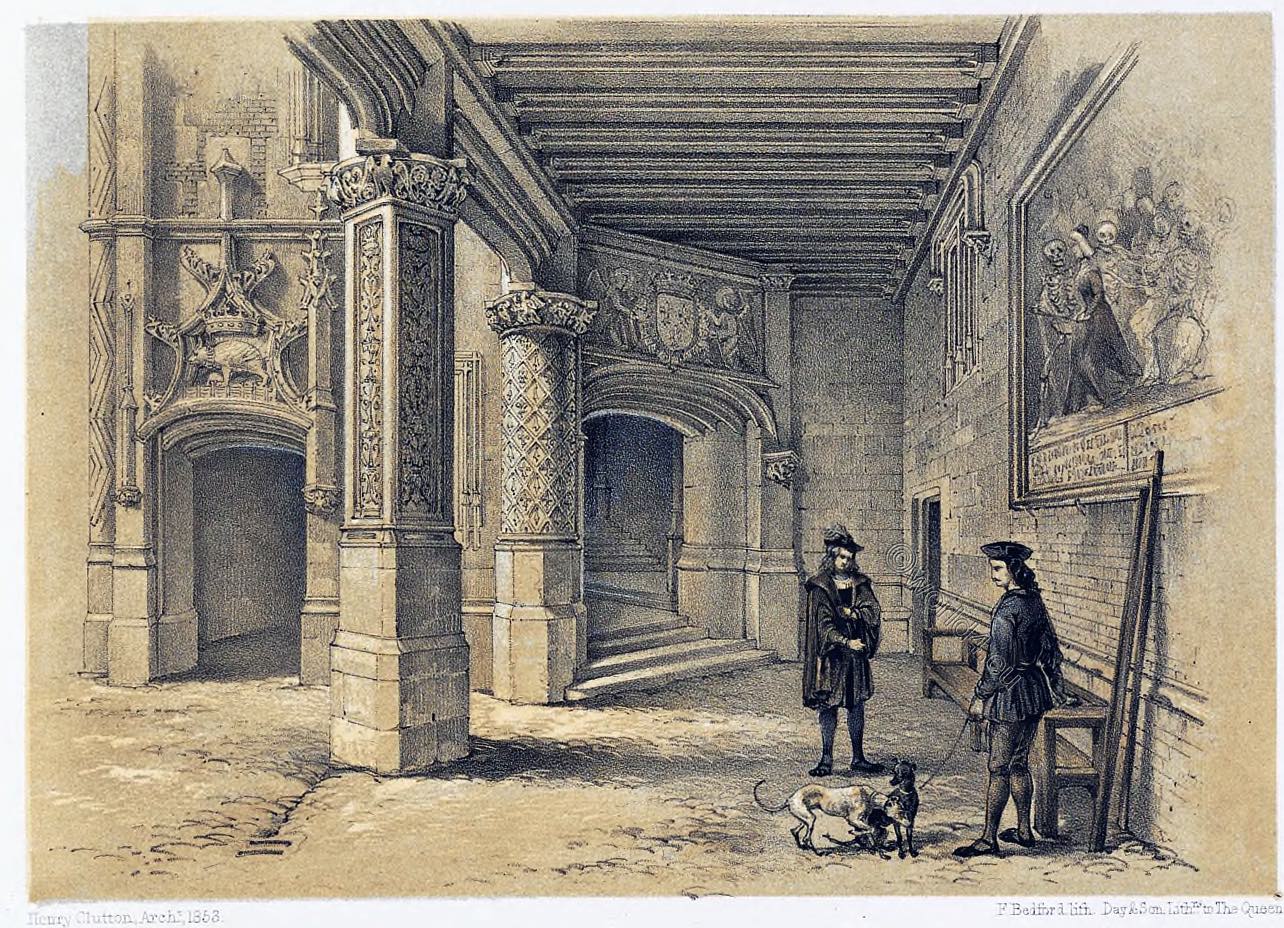
The apartments on the ground-floor consisted of a kitchen, constructed with a single pillar in the centre to receive the vaulting, a small guard chamber, and sundry other apartments, the purpose of which is unknown.
The first-floor contained the bedchamber and sitting-room of the king. From the balcony of the window of the former room Louis was accustomed to converse with Cardinal Amboise, whose hotel occupied one of the angles of the basse cour. The window is still shown from which the cardinal used to answer the inquiries of his master.
The entrance-gateway of this corps de logis, of which a view is given (Plate 7) has a large canopied recess over it. This recess, the back of which was decorated with gilt fleurs-de-lis upon an azure ground, once contained a bronze equestrian statue of Louis XII., which was of Italian workmanship. Above the doorway of the foot-entrance was sculptured the figure of a porcupine, now destroyed 4).
Below the statue of the king were these verses, composed by Fausto Andrelini, Louis’s favourite poet, who we are told was above composing in French:—
Hie, ubi natus erat, dextro Ludovicus Olympo
Sumpsit honoratâ Regia Sceptra Manu,
Felix qui tanti fulsit. Lux nuntia Regis.
Gallia non alio Principe digna fuit.
Faustus, 1498.
In the tympana of the dormer windows of the façade next the basse cour were the arms and ciphers of Louis and his second wife, Anne of Brittany. These memorials are destroyed, except those of the window over the entrance. This facade had, no doubt, at one time, a parapet, from the presence of the gargoyles, which are wanting on the opposite side, their place being supplied by water-pipes, for which the ornamental chases in the building still remain.
The roof is covered with the Angers slates; and the lead flashings upon the ridges of the main roofs, and those of the dormer windows, were historiated with the arms of France and Brittany, and with the badges of the cordelière and the porcupine. Traces of these remain, as also sundry small projections, from which it would appear that a lead ridge once completed the composition.
In the interior of the corps de logis no remains of coloured decorations have been preserved. The beams of the rooms were moulded; and the timbers of the attics, which are now so bare, appear as though they had once been lined with wainscot-work. There is a tradition, that the ladies of the court used these
attics.
4) The Porcupine, or Porc-épic, was an order founded by Louis, first duke of Orleans, who thereby sought to convince his rival, the duke of Burgundy, that he would be found armed at all parts. The motto of the order was, “Cominus et eminus,”— from far and near,— referring to the fabulous power attributed to the animal of darting out its quills.
From the description which has come down to us of the visit of the archduke and duchess of Austria to Blois, in 1501, we also learn that tapestry formed the
principal decoration of the walls of the rooms 5); that the fireplaces had dosselets of cloth of gold, frisé; and that, amongst other things, there was a gilt chain, fort bien menuisée, venant d’Italic.
It may be said generally of the work of Louis XII. at Blois, that there is a marked appearance of Italian influence in all its sculpture; and there can be little doubt but that the better-executed parts are the work of some of those artists whom, Philip de Commines informs us, Charles VIII. brought from Italy to decorate the chateau of Amboise.
Much of the foliage decorations consist of the acanthus, treated in a very graceful manner. The arabesques on the pillars of the arcade do not appear to be so well executed as the other parts; but in the little panel over the entrance door we see the Italian element, not only in the delicate sculpture, but even in some of the mouldings.
The basse cour, in front of the corps de logis, was formerly surrounded by the inferior offices of the palace, some hotels of the courtiers, and a large conventual church, in which latter building many royal personages had their obsequies celebrated before the final transit to the church of St. Denis. Louis XII. rebuilt the chapel of St. Calais,—of which two bays are destroyed,—and incorporated in its erection the remains of the former one before alluded to. From what remains of the chapel it appears to have been of some length, and terminated by an apse. The ribs of the vaulting interpenetrate upon round engaged columns, and the bosses which cover their intersection at the crown of the vault are circular medallions, containing the arms of Louis and his queen, Anne.
There was once within this chapel a tribune of wood, wonderfully carved, in which the king used to assist at the divine offices; also some very rich ornaments for the altar, and a picture of the Virgin, by Perugino. The whole of the open space, now called the Place des Jesuits, was once occupied by the gardens of the Palace.
These were much improved by Anne of Brittany, who had in her service several Italian gardeners in holy orders, which may explain the fact of a small oratory being attached to their residence. This oratory and residence still remain.
The area was divided into the higher and lower gardens, the latter of which were well furnished with trellised walks and small summer-houses. Of the latter, the most celebrated was in the shape of an octagon, with four niches in its sides, and was lighted from above by a lantern. Within, it was covered with beautiful menuiserie, and contained a marble fountain of three stages, some remains of which are preserved in the Museum.
5) The reader will find this fact confirmed by referring to the illustrations of Blois in Montfaucon’s “Antiquities of France.”
This little edifice was also extensively decorated with the cordelière; and it is said that to it Anne retired when the king, Louis, was excommunicated by the pope.
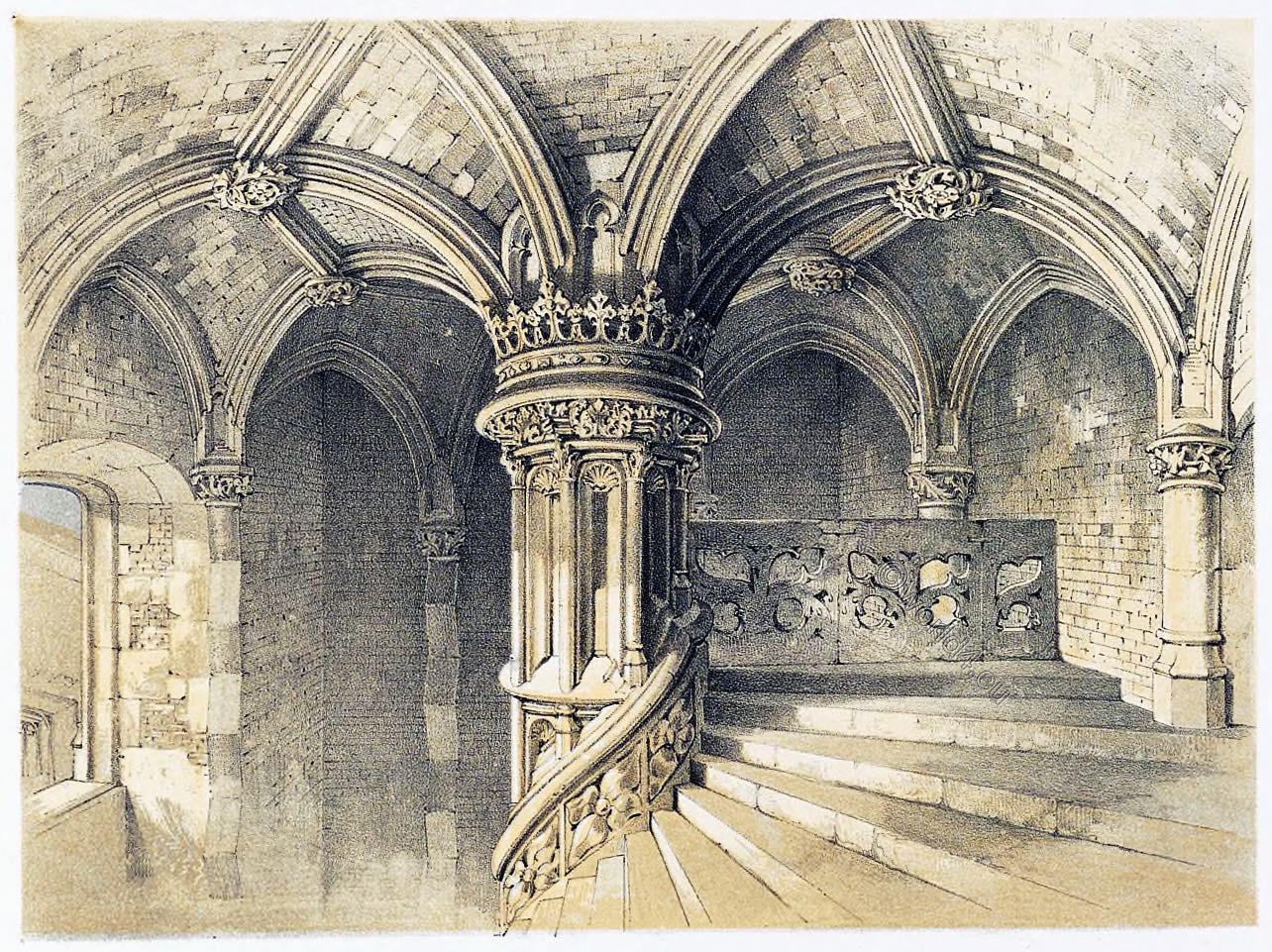
It was in this Palace that Louis XII. received the Archduke Maximilian of Austria, and his duchess, in 1504 (De la Saussaye) and we learn that these guests arrived at Blois riding on haquenées *) harnessed in red velvet, with six hundred horses in their procession. The duchess of Vendome, who had gone to meet the archduchess, followed, with her female attendants, on a haquenée caparisoned in black velvet.
*) A haquenée is a horse or more frequently a mare of gentle pace, usually going to the amble, frequently ridden by ladies of the Middle Ages.
On the arrival of the cortège in the basse cour, the archduke was received with the sound of trumpets, clarions, and tambourines. From the entry of the basse cour to the door of the Palace were two ranks of archers of the guard, clothed in their hoquetons d’orfévrerie, with halberds in their hands; from this door to the grand staircase were placed the Swiss; and from the staircase through the great hall to the king’s chamber the space was occupied by four hundred archers.
The account of the reception is exceedingly curious, and relates how that the throne of the king was placed on a large tapis vein before the fireplace; how the king received the archduchess; and how she consented to kiss him, having declared before she came to Blois that she would not do so; then, how the archduchess visited the queen, and little Madame Claude, who would cry, and was obliged to be taken away; and how the archduke supped with les Sieurs de Nevers, whilst the king supped alone upon bread and water, as he was very pious.
All this, and much more, is told with great accuracy, especially about the various rich tapestries in the chambers, and the ceremony of taking the spicery into the chamber of the archduchess; with a description of the drageoirs, or comfit-boxes, and other vessels employed on that occasion.
Source: Illustrations of mediaeval architecture in France, from the accession of Charles VI. to the demise of Louis XII.; by Henry Clutton. London, Nattali and Bond 1856.


